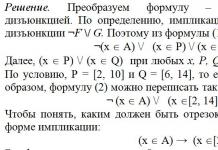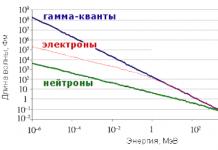The space between the stars is not empty. Giant clusters and rotating masses of gas and dust form beautiful, brightly glowing clouds of matter. Such clouds are called nebulae, and many of them are the very places where new stars are born. In the Orion Nebula, new stars are forming right now.
To see the clouds of the Milky Way with the naked eye, you will have to wait until there is no Moon in the sky, and choose a place for observation that is far from the bright lights of cities and towns. Then you will be able to discern a faintly luminous stripe running across the entire sky, about the width of your palm at arm's length.
The Milky Way is best viewed in the southern hemisphere, but on summer nights it is easy to see in the northern hemisphere. The light haze is intersected by “cracks” and “holes” that are clearly visible in the photographs.
For a long time, astronomers believed that these dark spots in the Milky Way were like tunnels among the stars. We now know that this is absolutely false. In reality, areas with few stars are clouds of gas and dust. Finely crushed dust and gas are scattered there, in the depths of space, and block the stars of the Milky Way from us.
Action of dust in space
On Earth, the setting Sun appears red because dust in the air scatters blue light more than red light. So most of the red rays pass through such hazy air, but not the blue ones. The situation is similar in space. Fog in outer space not only makes stars appear dimmer, it also makes them appear redder. Near the center of our Galaxy, in the constellation Sagittarius, there is so much dust that light does not pass through it at all, so the center of the Galaxy is absolutely invisible to us. To penetrate these dense clouds of dust and still find out what is happening in the very heart of the Milky Way, astronomers have to resort to the help of radio telescopes and infrared telescopes.
Under the influence of stellar singing, grains of dust in outer space warm up slightly, especially in the vicinity of very hot stars. Special infrared telescopes can see how dust particles emit heat, giving us the opportunity to look inside dust clouds. When, under the influence of gravitational forces, part of the gas or dust
When the cloud begins to compress, the cloud is forced to give up some of its energy. Thus, the collapse (compression) of the cloud releases energy. This energy is visible as infrared radiation.
star dust
The dust found in the Milky Way is stardust. The outer layers of giant stars are carried away into outer space. Old stars explode and scatter atoms of oxygen, carbon and iron into space. Silicon and iron are capable of forming tiny crystals, which then move through space, acquiring a coating of oxygen, carbon and nitrogen. These little grains are miniature chemical factories. On the surface of dust particles, atoms, for example, carbon and oxygen, attach to each other, forming molecules - say, carbon monoxide.
Hello! Hydrogen calls Earth!
The most common substance in interstellar space, and indeed in the Universe in general, is hydrogen. Radio astronomers hear the noise produced by this gas in all parts of our Galaxy. A hydrogen atom has only one electron. Sometimes an electron is thrown out of its orbit, and then a radio signal is sent into space. Each individual signal is very weak, but there is so much hydrogen in outer space that astronomers are able to obtain the overall, cumulative effect of all hydrogen in the form of radiation with a length of a full 21 cm. Hydrogen maps of the Milky Way reveal a beautiful spiral shape of our Galaxy with a large amount of hydrogen , located in its spiral arms.
Hydrogen clouds rotate in the Galaxy in the same way as planets revolve around the Sun. The speed at which a hydrogen cloud moves depends on how far it is from the center of our Galaxy. From the velocities of the hydrogen clouds we can calculate the total volume and shape of the Galaxy.
Nebulae emitting light
Interstellar clouds are mainly composed of hydrogen. In the depths of space they are too cold to glow. But sometimes a hydrogen cloud surrounds a hot star. And then the nebula appears before us in the form of a cloud of hot gas. The star heats the hydrogen until it glows pinkish. In the Large Magellanic Cloud there is a huge self-luminous nebula emitting pink light.
Nebulas that absorb light
The interstellar cloud may be too cold to emit light. And even vice versa, a cold-nose cloud can absorb the light of bright objects (for example, stars) located behind it. In this case, we see him as a dark silhouette against a light background. The Coalsack, a dark spot in the southern Milky Way, is a light-absorbing nebula visible to the naked eye.
Nebulae reflecting light
Sometimes a cold cloud in outer space can be visible because the dust it consists of reflects the light of nearby stars. The dust forms a delicate reflection nebula around the brightest stars in a cluster called the Pleiades. Nebulae that reflect light appear blue in photographs.
Interstellar medium
The matter located in the space between stars is called the interstellar medium. Most of it is concentrated in the spiral arms of the Milky Way. The temperature of interstellar matter ranges from a few degrees above absolute zero in the coldest dust clouds to millions of degrees in the hottest gas clouds.
If you were to go into space to the spiral arm of the Galaxy, you would find only about one atom of gas per cubic centimeter. There would be several hundred dust grains in a cubic kilometer of space. Thus, reversible, the interstellar medium is very rarefied. However, even in dense clouds the concentration of the substance can be 1000 times higher than the average. But even in a dense cloud there are only a few hundred atoms per cubic centimeter. The reason why we are still able to observe interstellar matter, despite its very rarefied nature, is that we see it in a large thickness of space. In a typical spiral galaxy, interstellar matter makes up 5 to 10 percent of all visible matter.
Our Solar System is located in a region of the Galaxy where the density of interstellar matter is unusually low. This area is called the Local Bubble; it extends in all directions for about 300 light years. It is possible that most of all the matter that could be located near the Sun was carried away under the influence of some processes. One of the proposed ideas is that once upon a time there was a colossal explosion of several large stars in the vicinity of the solar system. And the interstellar gas was thrown back by the explosive completeness into distant regions of outer space.
Giant molecular clouds
The most massive objects in the Milky Way are giant molecular clouds. Their mass can exceed the mass of the Sun by a million times. The Orion Nebula is just part of a giant molecular cloud that is about 500 times more massive than our Sun. In the mysterious depths of black clouds, astronomers have discovered an absolutely astonishing array of molecules. That space material includes water, ammonia and alcohol. There is also formic acid - the same one found in biting ants - as well as hydrocyanic acid. The acids from these molecules are classified as organic because they contain carbon.
The chemistry of these amazing clouds is actually very simple. Different atoms can be thought of as parts of a construction kit. Carbon, hydrogen, oxygen, nitrogen and other atoms can be combined together in a variety of ways - this is how all kinds of molecules are obtained, which do not collapse in the cloud due to its very low temperature. Simple elements can combine to form molecules of amino acids and proteins. On Earth, these same substances, found in nature, combine and form giant molecules of plant and animal organisms.
The space between the stars, with the exception of individual nebulae, appears empty. In fact, all interstellar space is filled with matter. Scientists came to this conclusion after at the beginning of the 20th century. Swiss astronomer Robert Trumpler discovered the absorption (weakening) of starlight on its way to an earthly observer. Moreover, the degree of its weakening depends on the color of the star. Light from blue stars is absorbed more intensely than from red stars. Thus, if a star emits the same amount of energy in blue and red rays, then as a result of the absorption of light, the blue rays are weakened more than the red ones and from the Earth the star appears reddish.
The substance that absorbs light is not distributed evenly in space, but has a ragged structure and is concentrated towards the Milky Way. Dark nebulae, such as the Coalsack and Horsehead nebulae, are places of increased density of absorbing interstellar matter. And it consists of the smallest particles - dust particles. The physical properties of dust grains have now been studied quite well.
In addition to dust, there is a large amount of invisible cold gas between the stars. Its mass is almost a hundred times greater than the mass of dust. How did the existence of this gas become known? It turned out that hydrogen atoms emit radio waves with a wavelength of 21 cm. Most of the information about interstellar matter is obtained using radio telescopes. This is how clouds of atomic neutral hydrogen were discovered.
A typical cloud of atomic neutral hydrogen has a temperature of about 70 K (-200 °C) and low density (several tens of atoms per cubic centimeter of space). Although such a medium is considered a cloud, for an earthling it is a deep vacuum, a billion times rarer than the vacuum created, for example, in a TV picture tube. The sizes of hydrogen clouds range from 10 to 100 pc (for comparison: stars are on average at a distance of 1 pc from each other).
Subsequently, even colder and denser clouds of molecular hydrogen were discovered, completely opaque to visible light. It is in them that most of the cold interstellar gas and dust is concentrated. These clouds are approximately the same in size as regions of atomic hydrogen, but their density is hundreds and thousands of times higher. Therefore, large molecular clouds can contain a huge mass of matter, reaching hundreds of thousands and even millions of solar masses. Molecular clouds, consisting mainly of hydrogen, also contain many more complex molecules, including the simplest organic compounds.
Some of the interstellar matter is heated to very high temperatures and “glows” in ultraviolet and X-rays. The hottest gas emits in the X-ray range, having a temperature of about a million degrees. This - coronal gas, so named by analogy with the heated gas in the solar corona. Coronal gas has a very low density: approximately one atom per cubic decimeter of space.
Hot rarefied gas is formed as a result of powerful explosions - supernova explosions. From the site of the explosion, a shock wave propagates through the interstellar gas and heats the gas to a high temperature, at which it becomes a source of X-ray radiation. Coronal gas has also been discovered in the space between galaxies.
So, the main component of the interstellar medium is gas, consisting of atoms and molecules. It is mixed with dust, containing about 1% of the mass of interstellar matter, and is penetrated by fast streams of elementary particles - cosmic rays - and electromagnetic radiation, which can also be considered components of the interstellar medium.
In addition, the interstellar medium turned out to be slightly magnetized. Magnetic fields are connected to clouds of interstellar gas and move with them. These fields are approximately 100 thousand times weaker than the Earth's magnetic field. Interstellar magnetic fields contribute to the formation of the densest and coldest clouds of gas from which stars condense. Cosmic ray particles also react to the interstellar magnetic field: they move along its field lines along spiral trajectories, as if winding around them. In this case, the electrons that make up cosmic rays emit radio waves. This so-called synchrotron radiation is generated in interstellar space and is reliably observed in the radio range.
Only relatively recently has it been possible to prove that stars do not exist in absolute emptiness and that outer space is not completely transparent. Nevertheless, such assumptions have been made for a long time. Back in the middle of the 19th century. Russian astronomer V. Struve tried (though without much success) using scientific methods to find irrefutable evidence that space is not empty, and that the light of distant stars is absorbed in it.
The presence of an absorbing rarefied medium was convincingly demonstrated less than a hundred years ago, in the first half of the 20th century, by comparing the observed properties of distant star clusters at various distances from us. This was done independently by the American astronomer Robert Trumpler (1896–1956) and the Soviet astronomer B.A. Vorontsov-Velyaminov (1904–1994), or rather, this is how one of the components of the interstellar medium was discovered - fine dust, due to which the interstellar medium turns out to be not completely transparent, especially in directions close to the direction of the Milky Way. The presence of dust meant that both the apparent brightness and the observed color of distant stars were distorted, and to know their true values required a rather complex accounting of extinction. Dust was thus perceived by astronomers as an annoying nuisance that interfered with the study of distant objects. But at the same time, interest arose in the study of dust as a physical medium - scientists began to find out how dust grains arise and are destroyed, how dust reacts to radiation, and what role dust plays in the formation of stars.
With the development of radio astronomy in the second half of the 20th century. It became possible to study the interstellar medium using its radio emission. As a result of targeted searches, radiation from neutral hydrogen atoms in interstellar space was discovered at a frequency of 1420 MHz (corresponding to a wavelength of 21 cm). Radiation at this frequency (or, as they say, in a radio link) was predicted by the Dutch astronomer Hendrik van de Hulst in 1944 on the basis of quantum mechanics, and it was discovered in 1951 after calculating its expected intensity by the Soviet astrophysicist I.S. Shklovsky. Shklovsky also pointed out the possibility of observing the radiation of various molecules in the radio range, which, indeed, was later discovered. The mass of interstellar gas, consisting of neutral atoms and very cold molecular gas, turned out to be about a hundred times greater than the mass of rarefied dust. But the gas is completely transparent to visible light, so it could not be detected using the same methods that dust was discovered.
With the advent of X-ray telescopes installed on space observatories, another, hottest component of the interstellar medium was discovered - a very rarefied gas with a temperature of millions and tens of millions of degrees. It is impossible to “see” this gas either from optical observations or from observations in radio links - the medium is too rarefied and completely ionized, but, nevertheless, it fills a significant fraction of the volume of our entire Galaxy.
The rapid development of astrophysics, which studies the interaction of matter and radiation in outer space, as well as the emergence of new observational capabilities, has made it possible to study in detail the physical processes in the interstellar medium. Entire scientific fields have emerged - cosmic gas dynamics and cosmic electrodynamics, which study the properties of rarefied cosmic media. Astronomers have learned to determine distances to gas clouds, measure the temperature, density and pressure of gas, its chemical composition, and estimate the speed of movement of matter. In the second half of the 20th century. A complex picture of the spatial distribution of the interstellar medium and its interaction with stars emerged. It turned out that the possibility of star formation depends on the density and amount of interstellar gas and dust, and stars (primarily the most massive of them), in turn, change the properties of the surrounding interstellar medium - they heat it, support the constant movement of gas, and replenish the medium with their matter , change its chemical composition. The study of such a complex system as “stars - interstellar medium” turned out to be a very difficult astrophysical task, especially considering that the total mass of the interstellar medium in the Galaxy and its chemical composition slowly change under the influence of various factors. Therefore, we can say that the entire history of our stellar system, lasting billions of years, is reflected in the interstellar medium.
Emission gas nebulae.
Most of the interstellar medium is not observable with any optical telescopes. The most striking exception to this rule is gaseous emission nebulae, which were observed with the most primitive optical means. The most famous of these is the Great Orion Nebula, which is visible even to the naked eye (provided you have very good vision) and is especially beautiful when viewed through strong binoculars or a small telescope.
Many hundreds of gaseous nebulae are known at various distances from us, and almost all of them are concentrated near the strip of the Milky Way - where young hot stars are most often found.
In emission nebulae, the gas density is much higher than in the space surrounding them, but even in them the concentration of particles is only tens or hundreds of atoms per cubic centimeter. Such a medium, by “earthly” standards, is indistinguishable from a complete vacuum (for comparison: the concentration of air particles at normal atmospheric pressure is on average 3·10 19 molecules per cm 3, and even the most powerful vacuum pumps will not create such a low density as exists in gas nebulae). The Orion Nebula has a relatively small linear size (20–30 light years). Since the diameters of some nebulae exceed 100 light. years, the total mass of gas in them can reach tens of thousands of solar masses.
Emission nebulae glow because they contain a rare type of star within or near them: hot blue supergiant stars. More correctly, these stars should be called ultraviolet, since their main radiation occurs in the hard ultraviolet range of the spectrum. Radiation with a wavelength shorter than 91.2 nm is very efficiently absorbed by interstellar hydrogen atoms and ionizes them, i.e. breaks the bonds between electrons and atomic nuclei - protons. This process (ionization) is balanced by the opposite process (recombination), as a result of which, under the influence of mutual attraction, electrons again combine with protons into neutral atoms. This process is accompanied by the emission of electromagnetic quanta. But usually an electron, when combining with a proton to form a neutral atom, does not immediately enter the lower energy level of the atom, but lingers on several intermediate ones, and each time during the transition between levels, the atom emits a photon, the energy of which is less than that of the photon that ionized the atom. As a result, one ultraviolet photon that ionized an atom is “split” into several optical ones. This is how the gas converts ultraviolet radiation from the star, invisible to the eye, into optical radiation, thanks to which we see the nebula.

Emission nebulae such as the Orion Nebula are gas heated by ultraviolet stars. Planetary nebulae, consisting of gas ejected by aging stars, also have the same nature.

But luminous gas nebulae of a slightly different nature are also observed, which arise during explosive processes in stars. First of all, these are the remains of exploded supernovas, an example of which is the Crab Nebula in the constellation Taurus. Such nebulae are nonstationary and are characterized by rapid expansion.

There are no bright ultraviolet sources inside the gaseous remnants of supernovae. The energy of their glow is the converted energy of the gas scattered after the explosion of the star, plus the energy released by the surviving supernova remnant. In the case of the Crab Nebula, this remnant is a compact and rapidly rotating neutron star, continuously emitting streams of high-energy elementary particles into the surrounding space. After tens of thousands of years, such nebulae, expanding, gradually dissolve in the interstellar medium.
Interstellar dust.
Even a quick glance at the image of any emission nebula of sufficiently large size allows you to see sharp dark details against its background - spots, jets, bizarre “bays”. These are small and denser clouds projected onto the light nebula located not far from it, opaque due to the fact that the gas is always mixed with interstellar dust, which absorbs light.

Dust is also present outside the gas clouds, filling (together with very rarefied gas) all the space between them. Such dust distributed in space leads to a dimming of the light of distant stars that is difficult to account for. The light is partially absorbed and partially scattered by small solid dust particles. The strongest attenuation is observed in directions close to the direction towards the Milky Way (to the plane of the galactic disk). In these directions, after traveling a thousand light years, visible light is attenuated by about 40 percent. If we consider that the extent of our Galaxy is tens of thousands of light years, it becomes clear that we can explore the stars of the galactic disk only in a small part of it. The shorter the wavelength of the radiation, the more light is absorbed, causing distant stars to appear reddened. Therefore, interstellar space is most transparent to long-wave infrared radiation. Only the densest gas and dust clouds remain opaque even to infrared light.
Traces of cosmic dust can be seen without a telescope. On a moonless summer or autumn night, the “split” stripe of the Milky Way in the region of the constellation Cygnus is clearly visible. It is associated with nearby dust clouds, a layer of which obscures the bright regions of the Milky Way lying behind them. Dark areas can be found in other areas of the Milky Way . The densest gas and dust clouds, projected onto areas of the sky rich in stars, appear as dark spots even in infrared light.
Sometimes bright stars are located near cold gas and dust clouds. Then their light is scattered by dust particles and a “reflection nebula” is visible.

Unlike emission nebulae, they have a continuous spectrum, like the spectrum of the stars that illuminate them.
By studying starlight reflected or transmitted through a cloud, we can learn a lot about dust particles. For example, the polarization of light indicates the elongated shape of dust grains, which acquire a certain orientation under the influence of the interstellar magnetic field. Solid cosmic dust particles have a size of about 0.1–1 microns. They probably have an iron-silicate or graphite core, covered with an ice “coat” of light elements. Graphite and silicate nuclei of dust grains apparently form in the relatively cool atmospheres of giant stars and are then ejected into interstellar space, where they cool and become covered with a coat of volatile elements.
The total mass of dust in the Galaxy is no more than 1% of the mass of interstellar gas, but this is also significant, since it is equivalent to the mass of tens of millions of stars such as the Sun.
Absorbing the light energy of stars, dust heats up to a low temperature (usually several tens of degrees above absolute zero), and emits the absorbed energy in the form of very long-wave infrared radiation, which on the scale of electromagnetic waves occupies an intermediate position between the optical and radio ranges (wavelength - tens and hundreds of micrometers). This radiation, received by telescopes mounted on specialized spacecraft, provides invaluable information about the mass of dust and the sources of its heating in our and other galaxies.
Atomic, molecular and hot gas.
Interstellar gas is primarily a mixture of hydrogen (about 70%) and helium (about 28%) with very little heavier chemical elements. The average concentration of gas particles in interstellar space is extremely small and does not exceed one particle per 1–2 cubic cm. A volume equal to the volume of the globe contains about 1 kg of interstellar gas, but this is only on average. The gas is very heterogeneous both in density and temperature.
The temperature of the bulk of the gas does not exceed several thousand degrees - not high enough for hydrogen or helium to be ionized. Such a gas is called atomic because it consists of neutral atoms. Cold atomic gas practically does not emit in the optical range, so for a long time almost nothing was known about it.
The most common atomic gas - hydrogen (symbol - HI) - is observed by radio emission at a wavelength of about 21 cm. Radio observations have shown that the gas forms clouds of irregular shape with a temperature of several hundred kelvins and a more rarefied and hotter intercloud medium. The total mass of atomic gas in the galaxy reaches several billion solar masses.
In the densest clouds, the gas cools, individual atoms combine into molecules, and the gas becomes molecular. The most common molecule, H2, does not emit radio or optical radiation (although these molecules do have absorption lines in the ultraviolet region), and molecular hydrogen is extremely difficult to detect. Fortunately, along with molecular hydrogen comes dozens of other molecules containing heavier elements such as carbon, nitrogen and oxygen. Based on their radio emission at certain, well-known frequencies, the mass of the molecular gas is estimated. Dust makes molecular clouds opaque to light, and they are visible as dark spots (veins) against the lighter background of emission nebulae.
Radio astronomy observations have made it possible to detect quite complex molecules in interstellar space: hydroxyl OH; water vapor H 2 O and ammonia NH, formaldehyde H 2 CO, carbon monoxide CO, methanol (wood alcohol) CH 3 OH, ethyl (wine) alcohol CH 3 CH 2 OH and dozens of other, even more complex molecules. All of them are found in dense and cold gas and dust clouds, the dust in which protects fragile molecules from the destructive influence of ultraviolet radiation from hot stars. Probably, the surface of cold dust grains is precisely the place where complex molecules are formed from individual atoms stuck to the dust grain. The denser and more massive the cloud, the greater the diversity of molecules found in it.
Molecular clouds are very diverse.

We see some small clouds intensively “evaporating” under the influence of light from nearby stars. There are, however, also giant, very cold clouds with a mass exceeding a million solar masses (there are more than a hundred similar formations in our Galaxy). Such clouds are called giant molecular clouds. What is essential for them is their own gravitational field, which keeps the gas from expanding. The temperature in their depths is only a few kelvins above absolute zero.
Young hot stars can heat and destroy molecular clouds with their short-wave radiation. Particularly a lot of energy is released and transferred to interstellar gas during supernova explosions, as well as by matter intensively flowing out of the atmospheres of hot stars of high luminosity (the stellar wind of massive stars). The gas expands and heats up to a million degrees or more. This hot, tenuous environment forms giant "bubbles" in the cooler interstellar gas, sometimes hundreds of light years across. Such gas is often called “coronal” gas, by analogy with the gas from the hot solar corona, although interstellar hot gas is several orders of magnitude rarer than the corona gas. Such hot gas is observed by weak thermal X-rays or ultraviolet lines belonging to some partially ionized elements.
Cosmic rays.
In addition to gas and dust, interstellar space is also filled with very energetic particles of “cosmic rays” that have an electrical charge - electrons, protons and the nuclei of some elements. These particles fly at almost the speed of light in all possible directions. Their main (but not the only) source is supernova explosions. The energy of cosmic ray particles is many orders of magnitude higher than their rest energy E = m 0c 2 (here m 0 is the rest mass of the particle, c is the speed of light), and is usually in the range of 10 10 – 10 19 eV (1 eV = 1.6 ґ 10 –19 J), in very rare cases reaching higher values. The particles move in the weak magnetic field of interstellar space, the induction of which is approximately one hundred thousand times less than that of the Earth's magnetic field. The interstellar magnetic field, acting on charged particles with a force depending on their energy, “confuses” the trajectories of the particles, and they continuously change the direction of their movement in the Galaxy. Only the most highly energetic cosmic rays move along slightly curved paths and therefore are not retained in the Galaxy, leaving for intergalactic space.
Particles of cosmic rays reaching our planet collide with air atoms and, breaking them, give birth to numerous new elementary particles that form real “showers”, falling onto the earth’s surface. These particles (they are called secondary cosmic rays) can be directly recorded by laboratory instruments. Primary cosmic rays practically do not reach the Earth's surface; they can be detected outside the atmosphere. But the presence of fast particles in interstellar space can also be determined by indirect signs - by the characteristic radiation that they produce during their movement.
Charged particles flying in an interstellar magnetic field are deviated from straight trajectories under the influence of the Lorentz force. Their trajectories seem to be “wound” on the lines of magnetic induction. But any non-rectilinear motion of charged particles, as is known from physics, leads to the emission of electromagnetic waves and a gradual loss of energy by the particles. The wavelength of cosmic particle radiation corresponds to the radio range. Particularly effective are light electrons, whose motion is most affected by the interstellar magnetic field due to their very low mass. This radiation is called synchrotron radiation because it is also observed in physics laboratories when electrons are accelerated in magnetic fields in special installations - synchrotrons, used to produce high-energy electrons.
Radio telescopes ( cm. RADIO ASTRONOMY) receive synchrotron radiation not only from all regions of the Milky Way, but also from other galaxies. This proves the presence of magnetic fields and cosmic rays there. Synchrotron radiation is noticeably enhanced in the spiral arms of galaxies, where the density of the interstellar medium is greater, the magnetic field is more intense, and supernova explosions—sources of cosmic rays—occur more often. A characteristic feature of synchrotron radiation is its spectrum, which is not similar to the spectrum of radiation from heated media, and strong polarization associated with the direction of the magnetic field.
Large-scale distribution of the interstellar medium.
The bulk of gas and dust is concentrated near the plane of our Galaxy. It is there that the observed emission nebulae and clouds of atomic and molecular gas are concentrated. A similar picture is observed in other galaxies similar to ours. When a distant galaxy is turned toward us so that its stellar disk is visible “edge-on,” the disk appears to be intersected by a dark stripe. The dark streak is a layer of the interstellar medium that is opaque due to the presence of dust particles.

The thickness of the layer of interstellar gas and dust is usually several hundred light years. years, and the diameter is tens and hundreds of thousands of St. years, so this layer can be considered relatively thin. The explanation for the concentration of the interstellar medium into a thin disk is quite simple and lies in the properties of gas atoms (and gas clouds) to lose energy when colliding with each other, which continuously occur in interstellar space. Due to this, gas accumulates where its total (kinetic + potential) energy is minimal - in the plane of the stellar disk, which attracts the gas. It is the attraction of the stars that prevents the gas from moving far from the plane of the disk.
But even inside the Galaxy’s disk, the gas is distributed unevenly. In the center of the Galaxy there is a molecular disk several hundred light years in size. years. Further from the center, the gas density decreases, but quickly increases again, forming a giant gas ring with a radius of more than 10 thousand light. years and a width of several thousand St. years. The sun is beyond it. In the vicinity of the Sun, the average densities of molecular and atomic gas are comparable, and at even greater distances from the center, atomic gas predominates. Inside the layer of the interstellar medium, the highest density of gas and dust is achieved in the spiral arms of the Galaxy. Molecular clouds and emission nebulae are especially common there, and stars are born.
The birth of stars.
When astronomers learned to measure the age of stars and identify short-lived young stars, it was discovered that star formation occurs most often where the interstellar gas and dust medium is concentrated - near the plane of our Galaxy, in its spiral arms. The closest star forming regions to us are associated with the complex of molecular clouds in Taurus and Ophiuchus. A little further away is the huge cloud complex in Orion, which contains a large number of newly born stars, including massive and very hot ones, and several relatively large emission nebulae. It is the ultraviolet radiation of the hot star that heats up part of one of the clouds, which we see as the Great Orion Nebula. Emission nebulae of the same nature as the Orion Nebula always serve as a reliable indicator of those regions of the Galaxy where stars are born.
Stars are born in the depths of cold molecular clouds, where, due to the relatively high density and very low temperature of the gas, gravitational forces play a very important role and are able to cause compression of individual densities of the medium. They are compressed under the influence of their own gravity and gradually warm up to form hot balls of gas - young stars. It is very difficult to observe the development of this process, since it can last millions of years and occurs in a poorly transparent (due to dust) environment.

Star formation can occur not only in large molecular clouds, but also in relatively small but dense ones. They are called globules. They are visible against the sky as compact and completely opaque objects. The typical size of globules is from tenths to several sq. years, mass - tens and hundreds of solar masses.
In general terms, the process of star formation is clear. Dust in the outer layers of the cloud blocks the light of stars located outside, so the cloud is deprived of external heating. As a result, the inner part of the cloud cools greatly, the gas pressure in it drops, and the gas can no longer resist the mutual attraction of its parts - compression occurs. The densest parts of the cloud compress the fastest, and stars form there. They always appear in groups. At first these are slowly rotating and slowly contracting relatively cold balls of gas of varying masses, but when the temperature in their depths reaches millions of degrees, thermonuclear reactions begin in the center of the stars, releasing a large amount of energy. The elasticity of the hot gas stops the compression, and a stationary star appears, emitting like a large heated body.
Very young stars are often surrounded by a dust shell - remnants of matter that have not yet had time to fall onto the star. This shell does not release starlight from inside and completely converts it into infrared radiation. Therefore, the youngest stars usually manifest themselves only as infrared sources in the depths of gas clouds. And only later the space around the young star clears and its rays break through into interstellar space. Some of the material surrounding the forming star can form a rotating disk of gas and dust around it, in which planets will eventually arise.
Stars like the Sun, after their formation, have little effect on the surrounding interstellar medium. But some of the stars being born have a very large mass - ten or more times more than that of the Sun. The powerful ultraviolet radiation from such stars and the intense stellar wind impart thermal and kinetic energy to large masses of surrounding gas. Some stars explode as supernovae, ejecting a gigantic mass of matter into the interstellar medium at high speeds. Therefore, stars are not only formed from gas, but also largely determine its physical properties. Stars and gas can be considered as a single system with complex internal connections. However, the details of the process of star formation are very complex and not yet fully understood. There are known physical processes that stimulate the compression of gas and the birth of stars, as well as processes that inhibit it. For this reason, the relationship between the density of the interstellar medium in a given region of the Galaxy and the rate of star formation in it is not unambiguous
Anatoly Zasov
Outside the galaxies lies intergalactic space.
The boundary between interplanetary and interstellar space is the heliopause, in which the solar wind is slowed down by interstellar matter. The exact distance of this border region from the Sun is not yet known; it is supposedly located at four times Pluto's distance from the Sun (approximately 24 billion kilometers).
Information on the size of the heliosphere and the physical conditions in the heliopause is expected from the US probes Pioneer 10, Pioneer 11, Voyager 1 and Voyager 2, the first man-made objects that will enter the region in about a year and begin sending back data.
The boundary between interstellar and intergalactic space is an outward flow of galactic gas that collides with intergalactic matter and forms the outer layer of the galaxy.
Travel in interstellar space is a popular theme in science fiction novels. Technically, such projects are not yet feasible due to the very large distances.
Wikimedia Foundation. 2010.
- House of Soviets (Kaliningrad)
- Stogov
See what “Interstellar space” is in other dictionaries:
interstellar space- tarpžvaigždinė erdvė statusas T sritis radioelektronika atitikmenys: engl. interstellar space vok. interstellarer Raum, m rus. interstellar space, n pranc. espace interstellaire, m... Radioelektronikos terminų žodynas
Interstellar matter- Map of the local interstellar cloud The interstellar medium (ISM) is the matter and fields that fill interstellar space inside galaxies. Composition: interstellar gas, dust (1% of the gas mass), interstellar magnetic fields, cosmic rays, as well as ... ... Wikipedia
Interstellar magnetic field- one of the components of the interstellar medium (See Interstellar medium). The intensity and structure of the magnetic field can be estimated from astronomical observations of various types. One of them is the study of the radio emission of the Galaxy,... ... Great Soviet Encyclopedia
Interstellar flight- Interstellar flight - travel between stars by manned vehicles or automatic stations. Four automatic stations Pioneer 10, Pioneer 11, Voyager 1, Voyager 2 reached the third escape velocity and left the solar... ... Wikipedia
Interstellar flights- travel between stars by manned vehicles or automatic stations. Spaceship flights occupy a significant place in science fiction. Four automatic stations Pioneer 10, Pioneer 11, Voyager 1, Voyager 2 reached the third... ... Wikipedia
Interstellar flights- Interstellar flights travel between stars by manned vehicles or automatic stations. Spaceship flights occupy a significant place in science fiction. Four automatic stations Pioneer 10, Pioneer 11, Voyager 1, Voyager 2... ... Wikipedia
Interstellar comet- Interstellar comets are comets that hypothetically exist in the interstellar medium, not connected by gravitational forces with any star. Although no such comet has yet been discovered, it is assumed that these objects are very... ... Wikipedia
Interstellar medium- Map of the local interstellar cloud Interstellar medium (ISM) matter and fields filling interstellar space inside galaxies ... Wikipedia
INTERSTELLAR MEDIUM- matter that fills the space between stars inside galaxies. Matter in the space between galaxies is called. intergalactic environment (see Clusters of galaxies. Intergalactic gas). Gas in shells around stars (circumstellar shells) often... ... Physical encyclopedia
Interstellar dust- Interstellar dust is solid microscopic particles, along with interstellar gas, filling the space between stars. It is currently believed that dust grains have a refractory core surrounded by organic matter or an icy shell.... ... Wikipedia


























